There are many names for lighting devices used in theatres and concert halls, including lighting unit, lighting instrument, light fitting, lighting fixture, luminaire and lantern. These terms are all synonymous and refer to a complete lighting package, consisting of the housing (or casing), lamp (or bubble), socket, reflector, electrical cord and connector, and often a lens, mounting clamp and colour frame.
Lanterns designed for theatre, film and television lighting come in two main types: spotlights and floodlights. Most of these spotlights and floodlights are designed as lighting fixtures to be mounted on overhead bars (pipes), vertical bars or floor stands, and as such are fitted with a mounting yoke and usually a pipe hook clamp. The yoke and clamp allow for the lantern to pan, tilt or rotate into (almost) any position and then lock into place.
Most lanterns are also fitted with colour frame clips to hold a square metal frame (for holding colour filters/gels) or other accessories, including barn doors, top hats, doughnuts and colour wheels.
Stage lighting fixtures are available for either 120 volt or 240 volt operation (240 volt in Australia) .Most use an incandescent (or electric filament) lamp or bubble. By changing the amount of electricity passing through the filament (the metal wire inside the lamp) it is possible to change the intensity or luminescence of the beam produced.
Lanterns range in wattage from 50 watts to over 10 000 watts. Display lighting, of the kind used in shops and museums for example, uses 50–300 watt fixtures. Theatre lighting employs mostly 500–2000 watt lanterns and film and television lighting uses 1000–10 000 watt fixtures.
The two main types of theatre lanterns, floodlights and spotlights, have a major difference: spotlights use a lens whereas floodlights do not. Spotlights are differentiated by the type of lens they use.
Section view of a floodlight Section view of a profile spotlight Section view of a PC (pebble convex)
Floodlights
Floodlights are the simplest of all theatre lanterns, consisting simply of a light source (and reflector) in a box with one open side. As floodlights do not use lenses, they provide a wide, unfocussed and even distribution of light over a large area. There are several types of floodlight, defined according to their use.
A single unit which is hung or floor mounted is simply called a flood. Floods are often used in rows or battens. A row of floods sitting on the ground to light a set are called a groundrow and a row of floods hung behind a border above stage are called borderlights or batten lights. A row of floods along the very front downstage edge of the stage are called footlights and a row of lights at the back of the stage to light the cyclorama are called cyclights. In almost all of these cases the strip of lights are in groups of three or four units, each with their own colour (red, blue, green and yellow).
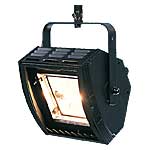

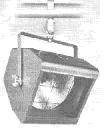
Three different styles of floodlight, all doing the same job, providing broad, even light.
Spotlights
There are many different spotlights. The most significant difference between them is the type and number of lenses installed. Here are some lenses:

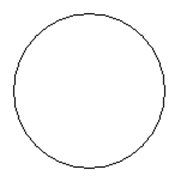
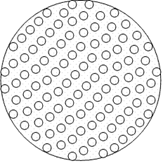
Plano Convex lens –side and front views. Pebble Convex lens – front view
PC used to stand for Plano Convex and refer to a lens with one completely flat side and one convex side. PC now refers to a number of different lenses: Plano Convex, Prism Convex and Pebble Convex. Prism Convex lenses have a prism cut out of the plano side of the lens and therefore create a softer-edged beam. Pebble Convex lenses are the most frequently encountered type of PC in modern lanterns and have a pebbled surface on the plano side of the lens, again creating a more diffused light with a softer edge.
While an older PC has a very hard edge to the beam (due to the clear plano convex lens), a modern PC usually has a Pebble Convex lens and therefore a softer edge to the beam. This is due to the many different angles of the edges the light passes through. Because it is directed in so many ways it is therefore not as concentrated as a standard plano convex lantern.
PCs are used to provide acting area lighting and localised lighting for specific areas on stage. The beam can be varied from spot to (almost) flood. While the plano convex lens produces a hard-edged beam, the prism and pebble convex lenses produce a softer edged circular beam.
A standard profile spot (left) and a typical PC pebble convex or plano convex with an amber colour filter (gel) attached (right). The extra length of the profile is due to the fact that there are two lenses inside the housing and the extra movement required of the lenses for more specific focussing.
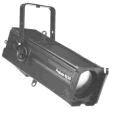

Fresnel spotlights are becoming one of the most frequently used lanterns in theatre lighting. The Fresnel (pronounced fren-ell) lens has a significant amount of material cut out of the convex side of the lens, with many angles built into the cuts (see the figure below). This creates a very diffused, yet still controllable beam. Fresnels are used to provide soft-edged wash lighting to acting areas or important set areas, or to provide a colour wash to a particular area. Fresnels have the ability to create a beam width ranging from spot to (almost) flood.
| | |
| Fresnel lens – side and front views | Two typical Fresnels |
Some Fresnels even have a pebbled or stippled plano side to diffuse the light further. Many Fresnels require barndoors to control or minimise spill light.
PAR (Parabolic Aluminised Reflectors) lanterns, often called PARs, PAR cans, or just cans, use a sealed beam lamp like an old car headlight. The filament, reflector and lens are combined into a single unit. The housing (or can) merely holds the lamp and any external hardware. They produce an elliptical (oval shaped) beam. PAR cans are a very efficient alternative to Fresnels if spill light is not a problem, as there is no control over a PAR's beam. In fact the beam spread and softness of edge are determined by the design of the lamp and the facets moulded into its lens.
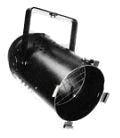
A typical PAR 64
PAR cans are very well suited to use in the general acting area, as well as for wash and colour wash lighting where flare and spill are not a problem.
Pin spots and beam lights are designed to provide a very narrow beam of light. Pin spots use a five to ten degree beam spread and beam lights have an almost parallel beam. This is achieved by using a parabolic reflector and no lens (or a flat lens). Pins and beams are useful for providing accents or highlights, tight lighting on actors or objects, and for 'searchlight' effects.
Profile spots or ellipsoidal reflector spotlights use either one or two plano convex lenses to create a narrow, directional beam that can be varied and focussed. Profile spotlights often incorporate internal metal shutters and/or an iris and can accept a projection template or gobo, which enables them to project light patterns or designs. Modern profile spots can vary the beam angle by several degrees and a zoom profile can vary the spread angle by 20 – 25 degrees. Profiles are also able to adjust the beam edge from very hard to quite soft.
Profile spots are used to provide concentrated light on specific areas, actors or important features of a set, as they can project intense light over long distances.
| | |
| | |
The followspot is simply a specialised, powerful profile spotlight which is mounted on a stand and usually fitted with its own dimmer, iris, colour magazine and shutters. It is situated in or above the auditorium and worked by a followspot operator. The light beam can be varied between one and ten degrees, have its size, edge and focus altered, and be moved around the stage to follow an actor.
| | | |
| A typical profile spotlight | Two different types of followspots | |

















